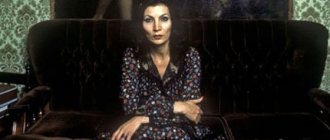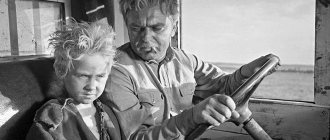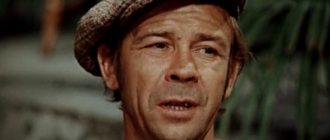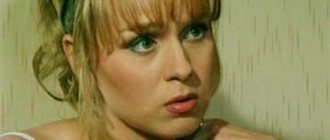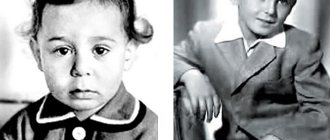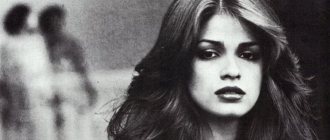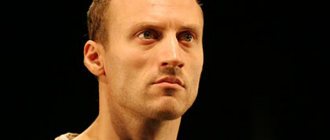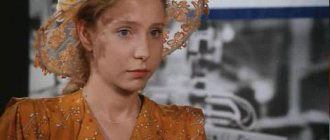Childhood
Isadora was born on May 27, 1877. This happened in the American state of California, in the city of San Francisco on Giri Street. Her real name is Dora Angela Duncan.
Her father, Joseph Charles Duncan, pulled off a major banking scam, after which he took all the money and fled, leaving his pregnant wife and three children without a livelihood.
The mother of the future dancer, Mary Dora Gray Duncan, experienced this tragedy in her own way; she could not eat anything except oysters, which she washed down with cold champagne. Subsequently, when journalists asked Isadora the question at what age she first started dancing, the woman jokingly replied that, probably, even in the womb, this is how champagne and oysters made themselves felt.
The girl's childhood cannot be called happy. The mother could barely carry four children on her shoulders and for a long time fought off the depositors deceived by their father, who every now and then rallied under their windows.
We must pay tribute to Isadora’s mother, the woman was not broken by such troubles and troubles. She promised herself that she would raise her children, provide everything they needed and raise them to be good people. My mother was a musician by profession, and in order to support her family, she had to work very hard, giving private lessons. Because of this, she simply physically could not pay due attention to her children, especially the little Dora.
In order not to leave the baby at home alone for a long time, she was sent to school at the age of five, while hiding the girl’s real age. Those unpleasant memories and feelings from childhood, when she felt uncomfortable and lonely among older, prosperous classmates, remained forever in Isadora’s heart and memory.
But the girls had good moments in their childhood, although they were rare. The selfless mother spent the evenings exclusively with her children; she played them works by Beethoven and other great composers, read William Shakespeare, instilling a love of art from an early age. The children, like chickens around a hen, united around their mother, forming a strong and united Duncan clan, which was ready to challenge the whole world if necessary.
Major changes
At the age of 13, Dora dropped out of school and decided to take up dancing seriously, for this she ended up with the then famous Loie Fuller, an actress and dancer in the modern style. This meeting became fateful; Isadora managed to conquer her mentor and began to perform with her on equal terms. At the age of 18, dancer Isadora Duncan goes to Chicago, where she begins performing her memorable routines in nightclubs.
The young girl performed barefoot, wearing a simple short chiton in the manner of the performers of Ancient Hellas, so she very quickly won over the audience, her performances were perceived as something outlandish and unusual. She deliberately did not want to wear pointe shoes and a tutu, and abandoned classical ballet movements in favor of her own, flexible and light ones. All this was innovation for that time. Isadora began to be called the dancing sandal.
It never occurred to anyone to call the flexible dancer in a light robe vulgar or obscene; her dance was a magical, mesmerizing spectacle. It was at this time that changes occurred in the personal life of Isadora Duncan; Ivan Mirotsky, an emigrant artist who was much older than the successful dancer, fell madly in love with the girl. Their romance was permeated with notes of romance, the lovers walked under the moonlight, kissed in the silence of the forest. And it seemed that things were heading towards marriage. However, the girl soon learned the harsh truth - the artist is married, his wife lives in Europe, and all this time he was involved with both of them. This breakup greatly affected Isadora; she expressed her pain and resentment through dance.
Passion for dance
We can say that already at the age of six, Dora opened her first dance school. It was then that she created them all over the world, and then the little girl and her sister simply taught the neighboring children to dance, to move beautifully and gracefully. And by the age of ten, Duncan was already earning her first money by dancing. She not only taught younger children, but also came up with new beautiful movements. These were her first steps in creating her own style of dancing.
Very early on, Isadora became interested in representatives of the opposite sex. No, she was not a promiscuous nymphet at all, she was simply amorous from a young age. For the first time, she liked a young man, Vernon, who worked in a pharmacy warehouse. Dora was only eleven years old at that time, but she was so persistent in seeking attention to herself that Vernon had to lie, saying that he was engaged. And only when the young man assured Isadora that he would soon marry, she left him behind. The girl was still very young, her love turned out to be childishly naive, but even then it became clear that she would grow into a persistent and eccentric person.
The school curriculum was difficult for Dora. And not because she didn’t understand something; on the contrary, Duncan was very capable. It was just that schoolwork made Isadora terribly bored. The girl ran away from class many times and wandered along the seashore, listening to the music of the surf and inventing light aerial dance moves to the sound of the waves.
Isadora was thirteen years old when she dropped out of school, saying that she did not see any point in learning, considered it a useless activity, and she could achieve a lot in life even without school education. She began to seriously pay attention to music and dancing. At first, the girl educated herself. But soon she was lucky, without anyone’s patronage or recommendations, without cronyism or money: she ended up with the famous American dancer and actress Loie Fuller, who was the founder of modern dance.
Fuller took Isadora as her student, but soon young Duncan began performing with her mentor. This went on for several years, and by the age of eighteen the talented student set off to conquer Chicago.
She showed her dance numbers in nightclubs, where she was presented to the public as an exotic curiosity, since Isadora performed barefoot and in a short ancient Greek tunic. The audience was shocked by Duncan's manner of performance; she danced so sensually and tenderly that it was impossible to take your eyes off her movements and rise from the chairs after the end of the dance. Such a length of a dress in those days was unthinkable even for progressive America, however, no one ever called Isadora’s dances vulgar, they were so light, graceful and free.
Isadora's performances were successful, which allowed her to improve her financial condition and set off to conquer Europe.
In 1903, she came with the entire Duncan family to Greece. Already in 1904, Isadora’s deafening performances took place in Berlin, Munich, and Vienna. In Europe she quickly gained fame.
In 1904, Isadora's first tour took place in St. Petersburg. Then she came to Russia more than once, where there were many admirers of her talent. Despite such success, Duncan was not a rich woman; she spent all the money she earned on opening new dance schools. There were times when she had no money at all, then Isadora’s friends helped her.
Dancing
Since childhood, Isadora perceived dancing differently than other children - the girl “followed her imagination and improvised, dancing as she pleased.” Dreams of the big stage led Duncan to Chicago, where she unsuccessfully auditioned for various theaters, and then to New York, where in 1896 the girl got a job in the theater of the famous critic and playwright John Augustine Daly.
Isadora Duncan as a child
In New York, the girl took lessons from the famous ballerina Marie Bonfanti for some time, but, quickly becoming disillusioned with ballet and feeling underappreciated in America, Isadora moved to London in 1898. In the capital of Great Britain, Isadora began performing in rich houses - good earnings allowed the dancer to rent a studio for classes.
From London, the girl headed to Paris, where her fateful meeting with Loie Fuller took place. Loi and Isadora had similar views on dance, viewing it as a natural movement of the body, rather than a rigid system of practiced movements, as in ballet. In 1902, Fuller and Duncan went on a dance tour of European countries.
Isadora Duncan in her youth
For many years of her life, Duncan traveled to perform in Europe and America, although she was not at all enthusiastic about touring, contracts and other fuss - Duncan believed that this distracted her from her true mission: training young dancers and creating something beautiful. In 1904, Isadora opened her first dance school in Germany and then another in Paris, but it was soon closed due to the outbreak of the First World War.
Isadora's popularity at the beginning of the 20th century is not in doubt. Newspapers wrote that Duncan's dance defined the power of progress, change, abstraction and liberation, and her photographs, which depicted the "evolutionary development of dance", each movement born from the previous one in an organic sequence, became famous throughout the world.
Dance of Isadora Duncan
In June 1912, French fashion designer Paul Poiret organized one of the most famous evenings, “La fête de Bacchus” (a re-creation of Louis XIV’s “bacchanalia” at Versailles), in a luxurious mansion in northern France. Isadora Duncan, dressed in a Greek evening dress designed by Poiret, danced on tables among 300 guests who managed to drink 900 bottles of champagne in a few hours.
After another tour in the USA in 1915, Isadora had to sail back to Europe - the choice fell on the luxury liner Lusitania, but due to a quarrel with creditors who threatened not to let the girl out of the country until she paid $12,000, Duncan ended up I had to board another ship. The Lusitania, torpedoed by a German submarine, sank off the coast of Ireland, killing 1,198 people.
Dancing Isadora Duncan
In 1921, Duncan's political sympathies brought the dancer to the Soviet Union. In Moscow, People's Commissar of Education of the RSFSR A.V. Lunacharsky invited the American woman to open a dance school, promising financial support. However, in the end, Isadora paid most of the expenses for maintaining the school from her own money, while experiencing hunger and everyday inconveniences.
The Moscow school quickly grew and gained popularity. The first performance by students of the institution took place in 1921 on the stage of the Bolshoi Theater in honor of the anniversary of the October Revolution. Isadora, together with her students, performed a dance program, which, among others, included the dance “Warsawianka” to the melody of a Polish revolutionary song. The program, during which the revolutionary banner was picked up from the hands of fallen fighters by full-strength fighters, was a success with the audience.
However, not everyone was impressed. Some were puzzled that this “older woman” risked going on stage too naked. Short (168 cm), with flabby full thighs and a not so elastic bust, Duncan could not be as light and graceful as in her youth - the years were taking their toll.
The dancer lived in Soviet Russia for 3 years, but various troubles forced Isadora to leave the country, leaving the management of the school to one of her students, Irma.
Personal life
After the apothecary warehouse employee Vernon, with whom Isadora fell in love at the age of eleven, for six years she was exclusively occupied with dancing, work and a career. Her early years passed without love affairs.
And starting from the age of 17, Duncan experienced all the feelings that are subject to a woman on Earth - love, disappointment, happiness, grief, pain, tragedy. She, a principled opponent of marriage, had a too turbulent personal life. Her lovers were different men: old and young, married and single, rich and poor, beautiful and talented, or none at all.
When she performed in Chicago nightclubs, a Polish emigrant, artist Ivan Mirotsky, fell madly in love with Isadora. He was not considered handsome; he wore a beard, and his head of hair was a bright red color. Nevertheless, Duncan took a liking to him, even though the man was almost thirty years older. Their affair with walks in the woods, kisses, and courtship lasted a year and a half. Things began to move towards the wedding, and its date had already been set when Isadora’s brother found out that Mirotsky was married, his wife lived in Europe. Duncan suffered painfully from this breakup; it became the first serious tragedy in her life. To forget about everything, she decided to leave America.
Then the failed actor Oscar Berezhi appeared in her life. She was 25 years old, Oscar became Isadora's first man, despite the fact that she constantly moved in bohemian circles. The wedding again did not work out, since Berezhi was offered a lucrative contract, and he chose a career over Isadora, leaving for Spain.
Four years later, Duncan met theater director Gordon Craig. Isadora gave birth to a daughter from him, but Craig soon abandoned them and married his old friend.
The heir to the famous dynasty that invented sewing machines, Paris Eugene Singer is the next man in Duncan's life. He really wanted to meet the dancer and one day after a performance he himself came to Isadora’s dressing room. She did not marry Singer, although she gave birth to a son from him.
The Unlucky Fate of Isadora Duncan
The mother of the future dance queen, Mary Duncan, earned money by teaching music lessons. Naturally, she taught music to her own children, who, according to her, were her best students. In addition, little Isadora took ballet lessons.
In 1895, the Duncan family moved to Chicago. The girl tried to find a job as a dancer in one of the city’s theaters and, as a result, after many days of searching and viewing, the director of one of the entertainment establishments invited her to sign a contract.
In Chicago, the beautiful Isadora had her first real admirer - the forty-five-year-old artist Ivan Mirotsky, who was Polish by birth. He even made an official proposal to the young girl. But later it turned out that the artist was married... With resentment in her soul and a broken heart, Isadora left for London.
Perhaps it was the right decision, since there her dancing career immediately took off. She danced at social events without a bra and tights, barefoot, introducing an element of ancient Greek dance into her non-standard performances. This innovation sent the public into a real frenzy.
Tragedy with children
She had a unique gift: Duncan had a presentiment when death was walking nearby. It happened more than once in her life that nature itself sent her some kind of sign, and soon after that one of Isadora’s relatives, friends or acquaintances died.
Therefore, when in 1913 she began to be tormented by terrible visions, the woman lost peace. She constantly heard funeral marches and saw small coffins. She was going crazy, worrying about her children. Duncan tried to make the kids' lives absolutely safe. With their common-law husband and children, they moved to a quiet, cozy place called Versailles.
One day Isadora was with her children in Paris, she had urgent business there, and she sent the kids with a driver and governess home to Versailles. On the way, the car stalled, the driver got out to find out the reason. At that moment, the car drove off and fell into the Seine River; the children could not be saved.
Isadora’s depression was terrible, however, she found the strength to speak out in defense of the driver, realizing that he also had small children.
She was like a stone, did not cry and never spoke to anyone about this tragedy. But one day, while walking by the river, I saw the ghost of my little children, they were holding hands. The woman screamed and became hysterical. A young man passing by rushed to her aid. Isadora looked into his eyes and whispered: “Save... Give me a child!” From this fleeting relationship she gave birth to a baby, but he lived only a few days.
Tragedy
In 1913, a terrible tragedy occurred in Isadora’s life: both of her children died in a car accident. Before that, for several weeks the woman was haunted by a bad feeling, but could not interpret it correctly. Despite the pain and despair, the mother, who had lost the most valuable thing, came out in defense of the driver, believing that in the tragedy that occurred he was only a pawn in the hands of fate and could not do anything against evil fate.
Out of pain and despair, the woman entered into a relationship with a young Italian man, from whom she became pregnant, but the baby died just a few days after his birth.
Here's how the woman felt about life's losses:
Life is like a pendulum: the more you suffer, the crazier your happiness; the deeper the sadness, the brighter the joy will be.
Duncan and Yesenin
In 1921, the greatest love came into her life. She met the Russian poet Sergei Yesenin.
A whirlwind romance began immediately on the day they met. She fell in love with him because Sergei reminded her of her little fair-haired son with blue eyes. The difference of eighteen years did not prevent them from becoming spouses in 1922; this was the first and only marriage in Duncan’s life.
Yesenin loved Isadora madly and admired her, they traveled around Europe and America, were happy, but not for long. He didn’t know English at all, and Isadora didn’t know Russian. But not only these difficulties in linguistic communication disrupted their idyll. Yesenin was depressed that everyone abroad perceived him only as the husband of the great Isadora Duncan. The passion passed, and an eternal love union did not work out. Sergei returned to Russia two years after the wedding, and Isadora continued to love him.
He died in 1925, and Duncan lost another blond, blue-eyed, and most beloved person in his life.
Romance novels
After a while, she met actor Oscar Berezi in Budapest. Their relationship quickly grew into love, but died out as quickly as it flared up.
But a serious relationship awaited her later, in Berlin. Isadora's chosen one was the English director Gordon Craig. Soon they had a daughter named Diedre. But the union of Isadora and Craig did not last long - the man saw in the dancer just a housewife, and not a creative person. Duncan did not expect such a turn of events, and decided to break off relations with her lover.
Then Isadora came up with the idea of opening her own dance school for children. But it cost incredible amounts of money. Soon she met one of the most influential people in Europe - Paris Eugene Sieger.
They became friends, and the man offered to help the dancer financially with opening a school. And then the feelings grew into love, and the couple had a son, Patrick. Finally, Isadora was happy! Her talent was recognized by millions, and love and harmony reigned at home.
Death
One close friend said about Isadora that for her, moving quickly was as necessary as breathing. Duncan spent her entire life running around like crazy, stopping only to eat and drink. She had all the prerequisites to crash her car at least twenty times.
Cars became some kind of obsession in Isadora’s life and played a mystical role. Her children died in a car accident, and the dancer herself crashed more than once while driving cars across Russia. During the European trip with Yesenin, they changed four cars, because Duncan simply terrorized the drivers, demanding to drive as quickly as possible, and several times these demands of hers ended in failure.
It was as if she had been playing with cars all her life: who would win? Cars brought her pain, disappointment and tragedy, and she again sat down and raced. On September 14, 1927, the final came in Nice, Duncan lost. She had a date with her next lover, Benoit Falchetto. Isadora sat in the passenger seat of his two-seater sports car and did not notice how the edge of a long shawl was left over the side and caught on the rear wheel. Benoit gave the gas, the car moved, the shawl stretched like a string, and in an instant broke Isadora’s neck. At 9.30 pm at the Saint-Roch clinic, doctors recorded the death of the great dancer.
Ridiculous death
Getting into accidents many times, the dancer was forced to change four cars during her tour with Yesenin alone. But she still put her life in danger, demanding breakneck speed from the drivers. Falchetto was an experienced driver, so there were no signs of trouble. Mary Desty, seeing off a friend, noticed how the fringe of the shawl began to drag on the ground in the immediate vicinity of the rear wheel. She wanted to scream, but didn't have time. Twisted with its knitting needles as it moved, the scarf drove Isadora's head into the side. The tension of the tissue fractured the woman's spine and tore her carotid artery. Her death was instant.
The driver could not understand why the engine was malfunctioning, and continued to press the gas pedal for several seconds. At this time, his great companion was already dead. The killer car was sold for a fantastic sum at that time - 200 thousand francs. Thousands of people came to the funeral at the Père Lachaise cemetery to say goodbye to their beloved, who passed away so tragically. For Russians, the great dancer is, first of all, Yesenin’s wife. After the death of her husband, Isadora Duncan renounced all copyrights to his works in favor of her mother and sisters and gained respect for her noble deed.
